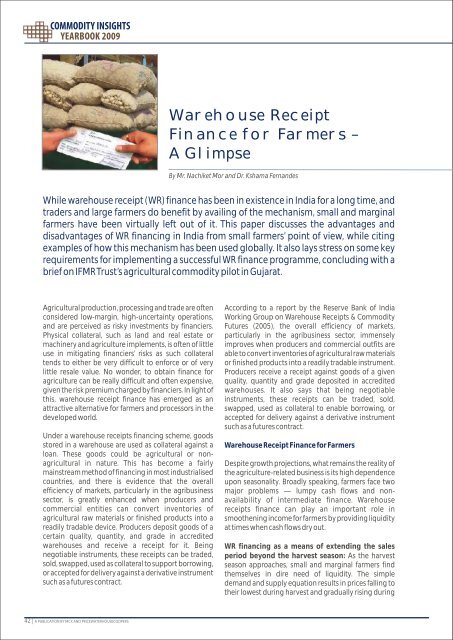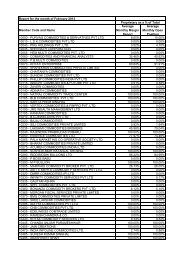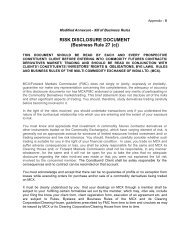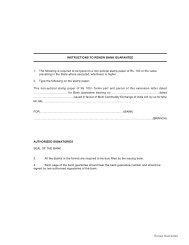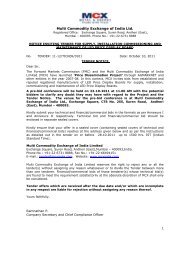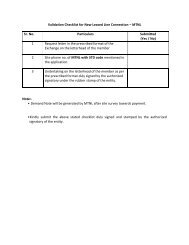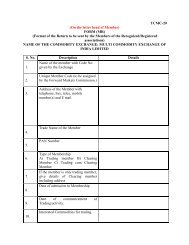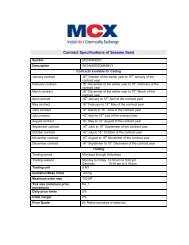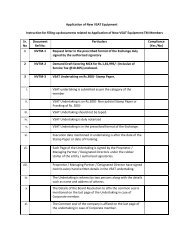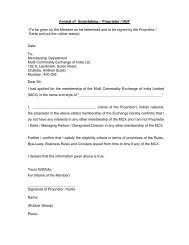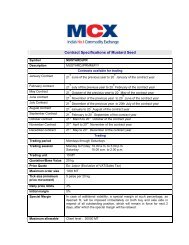Warehouse Receipt Finance for Farmers â A Glimpse - MCX in Marathi
Warehouse Receipt Finance for Farmers â A Glimpse - MCX in Marathi
Warehouse Receipt Finance for Farmers â A Glimpse - MCX in Marathi
Create successful ePaper yourself
Turn your PDF publications into a flip-book with our unique Google optimized e-Paper software.
<strong>Warehouse</strong> <strong>Receipt</strong><br />
<strong>F<strong>in</strong>ance</strong> <strong>for</strong> <strong>Farmers</strong> –<br />
A <strong>Glimpse</strong><br />
By Mr. Nachiket Mor and Dr. Kshama Fernandes<br />
While warehouse receipt (WR) f<strong>in</strong>ance has been <strong>in</strong> existence <strong>in</strong> India <strong>for</strong> a long time, and<br />
traders and large farmers do benefit by avail<strong>in</strong>g of the mechanism, small and marg<strong>in</strong>al<br />
farmers have been virtually left out of it. This paper discusses the advantages and<br />
disadvantages of WR f<strong>in</strong>anc<strong>in</strong>g <strong>in</strong> India from small farmers’ po<strong>in</strong>t of view, while cit<strong>in</strong>g<br />
examples of how this mechanism has been used globally. It also lays stress on some key<br />
requirements <strong>for</strong> implement<strong>in</strong>g a successful WR f<strong>in</strong>ance programme, conclud<strong>in</strong>g with a<br />
brief on IFMR Trust’s agricultural commodity pilot <strong>in</strong> Gujarat.<br />
Agricultural production, process<strong>in</strong>g and trade are often<br />
considered low-marg<strong>in</strong>, high-uncerta<strong>in</strong>ty operations,<br />
and are perceived as risky <strong>in</strong>vestments by f<strong>in</strong>anciers.<br />
Physical collateral, such as land and real estate or<br />
mach<strong>in</strong>ery and agriculture implements, is often of little<br />
use <strong>in</strong> mitigat<strong>in</strong>g f<strong>in</strong>anciers’ risks as such collateral<br />
tends to either be very difficult to en<strong>for</strong>ce or of very<br />
little resale value. No wonder, to obta<strong>in</strong> f<strong>in</strong>ance <strong>for</strong><br />
agriculture can be really difficult and often expensive,<br />
given the risk premium charged by f<strong>in</strong>anciers. In light of<br />
this, warehouse receipt f<strong>in</strong>ance has emerged as an<br />
attractive alternative <strong>for</strong> farmers and processors <strong>in</strong> the<br />
developed world.<br />
Under a warehouse receipts f<strong>in</strong>anc<strong>in</strong>g scheme, goods<br />
stored <strong>in</strong> a warehouse are used as collateral aga<strong>in</strong>st a<br />
loan. These goods could be agricultural or nonagricultural<br />
<strong>in</strong> nature. This has become a fairly<br />
ma<strong>in</strong>stream method of f<strong>in</strong>anc<strong>in</strong>g <strong>in</strong> most <strong>in</strong>dustrialised<br />
countries, and there is evidence that the overall<br />
efficiency of markets, particularly <strong>in</strong> the agribus<strong>in</strong>ess<br />
sector, is greatly enhanced when producers and<br />
commercial entities can convert <strong>in</strong>ventories of<br />
agricultural raw materials or f<strong>in</strong>ished products <strong>in</strong>to a<br />
readily tradable device. Producers deposit goods of a<br />
certa<strong>in</strong> quality, quantity, and grade <strong>in</strong> accredited<br />
warehouses and receive a receipt <strong>for</strong> it. Be<strong>in</strong>g<br />
negotiable <strong>in</strong>struments, these receipts can be traded,<br />
sold, swapped, used as collateral to support borrow<strong>in</strong>g,<br />
or accepted <strong>for</strong> delivery aga<strong>in</strong>st a derivative <strong>in</strong>strument<br />
such as a futures contract.<br />
Accord<strong>in</strong>g to a report by the Reserve Bank of India<br />
Work<strong>in</strong>g Group on <strong>Warehouse</strong> <strong>Receipt</strong>s & Commodity<br />
Futures (2005), the overall efficiency of markets,<br />
particularly <strong>in</strong> the agribus<strong>in</strong>ess sector, immensely<br />
improves when producers and commercial outfits are<br />
able to convert <strong>in</strong>ventories of agricultural raw materials<br />
or f<strong>in</strong>ished products <strong>in</strong>to a readily tradable <strong>in</strong>strument.<br />
Producers receive a receipt aga<strong>in</strong>st goods of a given<br />
quality, quantity and grade deposited <strong>in</strong> accredited<br />
warehouses. It also says that be<strong>in</strong>g negotiable<br />
<strong>in</strong>struments, these receipts can be traded, sold,<br />
swapped, used as collateral to enable borrow<strong>in</strong>g, or<br />
accepted <strong>for</strong> delivery aga<strong>in</strong>st a derivative <strong>in</strong>strument<br />
such as a futures contract.<br />
<strong>Warehouse</strong> <strong>Receipt</strong> <strong>F<strong>in</strong>ance</strong> <strong>for</strong> <strong>Farmers</strong><br />
Despite growth projections, what rema<strong>in</strong>s the reality of<br />
the agriculture-related bus<strong>in</strong>ess is its high dependence<br />
upon seasonality. Broadly speak<strong>in</strong>g, farmers face two<br />
major problems — lumpy cash flows and nonavailability<br />
of <strong>in</strong>termediate f<strong>in</strong>ance. <strong>Warehouse</strong><br />
receipts f<strong>in</strong>ance can play an important role <strong>in</strong><br />
smoothen<strong>in</strong>g <strong>in</strong>come <strong>for</strong> farmers by provid<strong>in</strong>g liquidity<br />
at times when cash flows dry out.<br />
WR f<strong>in</strong>anc<strong>in</strong>g as a means of extend<strong>in</strong>g the sales<br />
period beyond the harvest season: As the harvest<br />
season approaches, small and marg<strong>in</strong>al farmers f<strong>in</strong>d<br />
themselves <strong>in</strong> dire need of liquidity. The simple<br />
demand and supply equation results <strong>in</strong> prices fall<strong>in</strong>g to<br />
their lowest dur<strong>in</strong>g harvest and gradually ris<strong>in</strong>g dur<strong>in</strong>g<br />
42 | A PUBLICATION BY <strong>MCX</strong> AND PRICEWATERHOUSECOOPERS
1<br />
the lean season . Although farmers are aware of this<br />
seasonal trend, they cannot take advantage of this and<br />
benefit from it as they are hard put to organise<br />
immediate cash. A typical small farmer sells his crop<br />
when its prices are at their lowest. This crop is often<br />
bought by traders or village-level aggregators who<br />
hold the stock through the harvest season till prices<br />
pick up and then sell it at a profit. To cite some numbers,<br />
the seasonal variation <strong>in</strong> castor seed prices dur<strong>in</strong>g 2008<br />
was almost Rs.200 per 20kg which translates <strong>in</strong>to a<br />
profit of Rs.750 a bag of castor seed (which translates<br />
<strong>in</strong>to an annualised return of 88.9 %). If farmers are<br />
enabled to hold on to their crop beyond harvest, a part<br />
of the price benefit could accrue to them. So, by<br />
provid<strong>in</strong>g farmers with a mechanism to store and hold<br />
on to their produce, warehouse receipts f<strong>in</strong>ance<br />
enables the extension of the sales period beyond the<br />
harvest season.<br />
WRs as secure collateral <strong>for</strong> obta<strong>in</strong><strong>in</strong>g f<strong>in</strong>ance: Most<br />
banks are uncom<strong>for</strong>table <strong>in</strong> extend<strong>in</strong>g pre-harvest<br />
loans to farmers. <strong>Warehouse</strong> receipts <strong>for</strong>m sound<br />
collateral whose market value can be easily estimated<br />
and whose liquidity is much higher than conventional<br />
collateral such as land and mach<strong>in</strong>ery. In the event of<br />
default, the holder of the warehouse receipt has the<br />
first call on the underly<strong>in</strong>g goods or its value. This<br />
provides banks and f<strong>in</strong>anciers with the com<strong>for</strong>t to lend<br />
to the farmer without lengthy documentation and long<br />
process<strong>in</strong>g delays. <strong>Farmers</strong>, on their part, can avail of<br />
loans either to overcome immediate liquidity<br />
requirements or to f<strong>in</strong>ance future crop/<strong>in</strong>vestments on<br />
farm equipment or alternative bus<strong>in</strong>esses. Accord<strong>in</strong>g<br />
to the RBI Work<strong>in</strong>g Group report, on notion of reduced<br />
risk premia, collateralisation of agricultural <strong>in</strong>ventories<br />
us<strong>in</strong>g warehouse receipts will lead to <strong>in</strong>creased credit<br />
availability and reduced cost of credit. Besides, it will<br />
lead to mobilisation of ma<strong>in</strong>stream f<strong>in</strong>ancial resources<br />
<strong>in</strong>to the agricultural sector.<br />
In their study on the use and impact of warehouse<br />
receipts <strong>in</strong> develop<strong>in</strong>g and transition economics,<br />
Lacroix and Varangis (1996) concluded that warehouse<br />
receipts are an important addition to the store of<br />
negotiable <strong>in</strong>struments <strong>in</strong> a country’s f<strong>in</strong>ancial sector.<br />
Accord<strong>in</strong>g to them, they not only provide important<br />
long-term economic benefits but also have immediate<br />
positive impact on the farmer’s life.<br />
Is There a Downside <strong>for</strong> the Farmer<br />
While avail<strong>in</strong>g of f<strong>in</strong>ance aga<strong>in</strong>st warehouse receipts<br />
appears to be an attractive option <strong>for</strong> the farmer, there<br />
are concerns about its <strong>in</strong>herent speculative nature. One<br />
must seriously look <strong>in</strong>to a likely adverse outcome: this<br />
f<strong>in</strong>anc<strong>in</strong>g avenue may encourage farmers to take<br />
speculative positions hav<strong>in</strong>g the potential of result<strong>in</strong>g<br />
<strong>in</strong> losses beyond their risk-tak<strong>in</strong>g ability. <strong>Warehouse</strong><br />
receipt f<strong>in</strong>anc<strong>in</strong>g is profitable only when the expected<br />
rise <strong>in</strong> the value of the stored product is actually more<br />
than the cost of storage plus that of the borrowed<br />
funds (i.e., loan pr<strong>in</strong>cipal plus <strong>in</strong>terest payments, bank<br />
fees, etc).<br />
Many would argue that farmers ought to conf<strong>in</strong>e their<br />
activity to the area of their core competence — farm<strong>in</strong>g<br />
— and not <strong>in</strong>dulge <strong>in</strong> speculation. However, <strong>in</strong> the<br />
absence of a readily accessible hedg<strong>in</strong>g mechanism,<br />
the Indian farmer is a speculator <strong>in</strong> any case. From the<br />
po<strong>in</strong>t of time he sows the seed till the po<strong>in</strong>t of time he<br />
sells the crop <strong>in</strong> the market the farmer is long on the<br />
commodity, unless he hedges his long spot exposure<br />
by sell<strong>in</strong>g his produce <strong>in</strong> a <strong>for</strong>wards, futures or options<br />
market, which he has no access to <strong>in</strong> India. Most<br />
farmers who sell their stand<strong>in</strong>g crop to traders and<br />
other local f<strong>in</strong>anciers be<strong>for</strong>e harvest do so at suboptimal<br />
rates under tremendous liquidity pressure and<br />
not from the po<strong>in</strong>t of view of hedg<strong>in</strong>g their exposure.<br />
So, the contention that farmers should not engage <strong>in</strong><br />
speculative activity because it is not their core<br />
competence is someth<strong>in</strong>g that must be looked <strong>in</strong>to <strong>in</strong><br />
the light of alternatives available. <strong>Warehouse</strong> receipt<br />
f<strong>in</strong>anc<strong>in</strong>g is <strong>in</strong> essence a speculative activity. Avail<strong>in</strong>g of<br />
the facility simply extends farmers’ already exist<strong>in</strong>g<br />
price exposure beyond the harvest, provid<strong>in</strong>g him with<br />
a readily available cash flow and a potential upside.<br />
And, <strong>in</strong> general, even if the farmer wishes to sell <strong>in</strong> the<br />
spot market, it allows him to do price averag<strong>in</strong>g (thus<br />
reduc<strong>in</strong>g his exposure to “impact” cost) by sell<strong>in</strong>g his<br />
harvest gradually <strong>in</strong>stead of be<strong>in</strong>g <strong>for</strong>ced to sell the<br />
entire quantity on a s<strong>in</strong>gle day.<br />
1 The persistence of this arbitrage is a conundrum. If <strong>in</strong>deed this pattern was risk-less and the large traders or buyers were not credit constra<strong>in</strong>ed then, at least <strong>for</strong><br />
non-perishables, the return from this arbitrage should have been lower than the cost of f<strong>in</strong>anc<strong>in</strong>g and storage costs. In perishables, wherever possible, it should<br />
have led to more aggressive “calendar<strong>in</strong>g” (more distributed production throughout the year). However, <strong>in</strong> almost all commodities this arbitrage persists. It is<br />
possible that the existence of the “peso problem” (the risk of a sudden, completely unexpected precipitous fall <strong>in</strong> value that is rationally anticipated by the market<br />
– first po<strong>in</strong>ted out by Rogoff (1980)) makes this arbitrage both persistent and highly risky. If <strong>in</strong>deed that is the case, then one wonders if availability of warehouse<br />
receipt f<strong>in</strong>ance <strong>for</strong> the small farmer is a boon or a curse (discussed later <strong>in</strong> the note). Two alternate directions however look promis<strong>in</strong>g: commodity <strong>for</strong>ward<br />
contracts to be offered to farmers at the time of sow<strong>in</strong>g (so that they may “square off” the “long” position that they create as soon as they commit themselves to<br />
plant<strong>in</strong>g a particular crop and thereby lock <strong>in</strong> their profit marg<strong>in</strong>s) and an options contract or least a delta hedge (s<strong>in</strong>ce options contracts on commodities are not<br />
legal <strong>in</strong> India) which allows the farmer to buy protection aga<strong>in</strong>st a further drop <strong>in</strong> commodity prices but reta<strong>in</strong> the right to benefit from a rise <strong>in</strong> prices.<br />
EXPERTS’ VIEWS | 43
<strong>Warehouse</strong> <strong>Receipt</strong> F<strong>in</strong>anc<strong>in</strong>g – International<br />
Experience<br />
Experiences around the world suggest that warehouse<br />
receipt f<strong>in</strong>anc<strong>in</strong>g can be a profitable avenue <strong>for</strong> both<br />
the farmer and the f<strong>in</strong>ancier. TechnoServe <strong>in</strong> Ghana has<br />
achieved considerable success <strong>in</strong> its <strong>in</strong>ventory credit<br />
programme over the past two decades. Accord<strong>in</strong>g to<br />
TechnoServe’s Inventory Credit Programme <strong>in</strong> Ghana<br />
by Frank Hicks, the firm believes that only the<br />
confidence of be<strong>in</strong>g able to sell the produce at a<br />
reasonable profit to buyers can be the <strong>in</strong>centive <strong>for</strong><br />
small and marg<strong>in</strong>al producers, constitut<strong>in</strong>g 60% of<br />
Ghana’s farm<strong>in</strong>g population, to augment both<br />
production and productivity, and supply to local<br />
<strong>in</strong>dustries and exporters. As <strong>in</strong> most agricultural<br />
markets <strong>in</strong>clud<strong>in</strong>g India, small farmers rema<strong>in</strong> the<br />
classic “price takers”, cut off from <strong>in</strong><strong>for</strong>mation flow<strong>in</strong>g<br />
<strong>in</strong>to and out of the market and profitable market<br />
opportunities. To improve their conditions, Hicks says,<br />
TechnoServe ushered <strong>in</strong> the concept of <strong>in</strong>ventory<br />
credit <strong>in</strong> Ghana <strong>in</strong> 1989. The idea was to create an<br />
opportunity <strong>for</strong> these farmers to take advantage of<br />
seasonal price sw<strong>in</strong>gs (used smartly by local traders) to<br />
mitigate risks <strong>for</strong> banks that were hesitant about<br />
lend<strong>in</strong>g <strong>in</strong> the rural belt and to <strong>in</strong>crease food security<br />
<strong>for</strong> farmers who can buy back (or “redeem”) their<br />
produce rather than sell it.<br />
Participat<strong>in</strong>g farmers usually <strong>for</strong>m groups of 20-50<br />
members to store their produce and carry it <strong>in</strong>to the<br />
lean season when prices are at their peak — much<br />
higher than harvest time price levels. At the same time,<br />
they have the flexibility to exercise one of the follow<strong>in</strong>g<br />
options:<br />
• can decide to sell the produce through the group,<br />
us<strong>in</strong>g the proceeds to repay the bank <strong>for</strong> its credit<br />
and the group <strong>for</strong> the use of storage facilities,<br />
earn<strong>in</strong>g a net profit of 40 to 100%;<br />
• They can take back the produce from the group to<br />
consume as food, repay<strong>in</strong>g the bank loan and the<br />
group’s storage costs, and still sav<strong>in</strong>g a substantial<br />
amount by avoid<strong>in</strong>g high lean season food prices.<br />
TechnoServe has ref<strong>in</strong>ed the model of <strong>in</strong>ventory credit<br />
and expanded its application to other areas <strong>in</strong> Ghana.<br />
At preset, it is offer<strong>in</strong>g facilitat<strong>in</strong>g over 100 farmers’<br />
groups access <strong>in</strong>ventory credit. For nearly two decades<br />
now the participat<strong>in</strong>g farmers have ma<strong>in</strong>ta<strong>in</strong>ed a cent<br />
per cent on-time loan repayment record, significantly<br />
improved their <strong>in</strong>comes and agricultural production,<br />
cut down post-harvest losses and accumulated capital<br />
to <strong>in</strong>vest <strong>in</strong> other agricultural activities.<br />
In a similar ef<strong>for</strong>t, the RBI Work<strong>in</strong>g Group report says,<br />
PTA Bank <strong>in</strong> Kenya f<strong>in</strong>ances coffee export<strong>in</strong>g farmers by<br />
accept<strong>in</strong>g warehouse receipts as collateral. It also offers<br />
them a put option, purchased at the London<br />
Commodity Exchange, which guarantees sellers a<br />
m<strong>in</strong>imum price <strong>for</strong> the coffee <strong>in</strong> storage. By assur<strong>in</strong>g a<br />
floor price <strong>for</strong> the stored coffee, PTA Bank can provide<br />
f<strong>in</strong>ance <strong>for</strong> a higher percentage of the value of coffee<br />
than it could justify <strong>in</strong> the absence of the floor price.<br />
Accord<strong>in</strong>g to Lamon Rutten (then Coord<strong>in</strong>ator –<br />
commodity market<strong>in</strong>g, risk management and f<strong>in</strong>ance<br />
at United Nations Conference on Trade and<br />
Development), <strong>in</strong> Venezuela, under a system<br />
developed by private firm Induservices, provided<br />
capital enhancement to warehouse receipts on<br />
seasonal maize stocks. And this enabled the firm to<br />
attract huge <strong>in</strong>vestment to f<strong>in</strong>ance maize stocks.<br />
Aga<strong>in</strong> <strong>in</strong> Colombia, Rutten said, a more complex<br />
structure, <strong>in</strong>troduced <strong>in</strong> mid-2000, made it possible <strong>for</strong><br />
cattlemen to receive strong f<strong>in</strong>anc<strong>in</strong>g support to feed<br />
their cattle – at rates determ<strong>in</strong>ed through the<br />
competition among <strong>in</strong>stitutional <strong>in</strong>vestors on the<br />
country’s stock and commodity markets.<br />
Keys to Successful Implementation of a <strong>Warehouse</strong><br />
<strong>Receipt</strong>s Programme<br />
Accord<strong>in</strong>g to the RBI Work<strong>in</strong>g Group report, to work<br />
effectively, warehouse receipts require a recognised<br />
foundation <strong>in</strong> law ensur<strong>in</strong>g that the ownership<br />
established by the receipts is not challenged.<br />
<strong>Warehouse</strong> receipts must be functionally equivalent to<br />
stored commodities with well-def<strong>in</strong>ed rights, liabilities,<br />
and duties of each party to a warehouse receipt (<strong>for</strong><br />
example a farmer, a bank, or a warehouseman). They<br />
must be freely transferable by delivery and<br />
endorsement and the holder of a warehouse receipt<br />
must be first <strong>in</strong> l<strong>in</strong>e to receive the stored goods or their<br />
fungible equivalent on liquidation or default of the<br />
warehouse. A robust legal framework is a prerequisite<br />
to warehouse receipts be<strong>in</strong>g treated as secure<br />
collateral.<br />
Also essential is a warehouse <strong>in</strong>frastructure, grad<strong>in</strong>g<br />
and collateral management system that provides<br />
guarantees on quality, quantity and storage of<br />
commodities, thus assur<strong>in</strong>g that the quantities of<br />
goods stored match those specified by the warehouse<br />
receipt and also their quality is the same as stated on<br />
the receipt. This will give farmers the confidence to<br />
store their produce and banks the com<strong>for</strong>t to accept<br />
warehouse receipts as secure collateral <strong>for</strong> f<strong>in</strong>anc<strong>in</strong>g<br />
agricultural <strong>in</strong>ventories.<br />
44 | A PUBLICATION BY <strong>MCX</strong> AND PRICEWATERHOUSECOOPERS
And f<strong>in</strong>ally what is required is a comb<strong>in</strong>ation of fair and<br />
transparent spot and futures markets that provide<br />
liquidity and price discovery, enabl<strong>in</strong>g both farmers<br />
and banks to value and sell warehouse receipts at short<br />
notice if need be.<br />
In the Indian context, the proposed Warehous<strong>in</strong>g<br />
(Development and Regulation) Act, 2007 <strong>in</strong>corporates<br />
almost all the a<strong>for</strong>esaid legal and warehouse<br />
<strong>in</strong>frastructure related requirements. Once approved<br />
and implemented, it should provide a sound basis <strong>for</strong><br />
develop<strong>in</strong>g and promot<strong>in</strong>g warehouse receipt-backed<br />
trade and f<strong>in</strong>ance activity <strong>in</strong> the country.<br />
IFMR Trust’s Pilot <strong>in</strong> Kadi Taluka (Gujarat)<br />
In pursuit of its mission <strong>for</strong> f<strong>in</strong>ancial <strong>in</strong>clusion, IFMR<br />
Hold<strong>in</strong>gs has ventured <strong>in</strong>to the agricultural space.<br />
Deal<strong>in</strong>g exclusively with small and marg<strong>in</strong>al farmers <strong>in</strong><br />
the Kadi Taluka of Mehasana <strong>in</strong> Gujarat, three of its<br />
entities, Agricultural Term<strong>in</strong>al Markets Network<br />
Enterprise (ATMNE), IFMR Hold<strong>in</strong>gs, and IFMR Capital<br />
are work<strong>in</strong>g together on a pilot with the follow<strong>in</strong>g<br />
objectives:<br />
• To provide price discovery to farmers <strong>for</strong> their crops<br />
<strong>in</strong> a fair and transparent manner (ATMNE);<br />
• To explore other services required but not available<br />
to small farmers currently such as transportation<br />
from the village to the market/buyer, village level<br />
warehous<strong>in</strong>g capability, and agricultural extension<br />
services (ATMNE and IFMR Hold<strong>in</strong>gs);<br />
• To provide commodity-backed f<strong>in</strong>ance to farmers<br />
who would like to avail of f<strong>in</strong>ance aga<strong>in</strong>st the<br />
commodity as collateral (IFMR Hold<strong>in</strong>gs);<br />
• To explore other f<strong>in</strong>ancial products and services<br />
required but not available to small farmers currently<br />
such as commodity <strong>for</strong>ward contracts and deltahedg<strong>in</strong>g<br />
(IFMR Hold<strong>in</strong>gs and ATMNE);<br />
• To develop tradable Asset-Backed <strong>Warehouse</strong><br />
<strong>F<strong>in</strong>ance</strong> <strong>Receipt</strong>s (ABWFRs) so that they may be sold<br />
to mutual funds and other f<strong>in</strong>ancial <strong>in</strong>stitutions<br />
(IFMR Capital).<br />
As part of this pilot, the three IFMR Trust entities are<br />
work<strong>in</strong>g with the National Spot Exchange Ltd. (NSEL) to<br />
help farmers realise the best possible price <strong>for</strong> their<br />
agricultural commodities. ATMNE is an <strong>in</strong>stitutional<br />
trad<strong>in</strong>g and clear<strong>in</strong>g member and provides trad<strong>in</strong>g<br />
access to small and marg<strong>in</strong>al farmers. IFMR Hold<strong>in</strong>gs<br />
provides warehouse receipt f<strong>in</strong>ance, help<strong>in</strong>g farmers<br />
wait out the low price realisation period dur<strong>in</strong>g harvest.<br />
This is <strong>in</strong> l<strong>in</strong>e with IFMR Trust's mission of ensur<strong>in</strong>g<br />
complete access of f<strong>in</strong>ancial services to every<br />
<strong>in</strong>dividual and every enterprise. Towards this, after<br />
extensive survey, Dharampur, a village 20 km from Kadi<br />
town, with 1,000 acres under castor production and a<br />
population of 3,000, has been identified as an ideal<br />
village to operate the pilot from.<br />
Trad<strong>in</strong>g operations: The trad<strong>in</strong>g facility is located at<br />
Kadi <strong>in</strong> the exchange-managed warehouse premises.<br />
As part of the servicer agreement, the exchange<br />
provides guarantee on quality, quantity, and storage of<br />
commodities <strong>in</strong> the warehouses managed by it. The<br />
electronic exchange market provides nationwide<br />
access to buyers and sellers. The first crop to be traded<br />
was castor seed. While the market is still at its nascent<br />
stage, its volumes have been encourag<strong>in</strong>gly large. The<br />
market caters to farmers from around 125 villages<br />
around Kadi. <strong>Farmers</strong> come to the warehouse with their<br />
commodities which are then put through a standard<br />
weigh<strong>in</strong>g and quality test<strong>in</strong>g process. Depend<strong>in</strong>g upon<br />
the quality, weight adjustments are made and the<br />
commodity is packed <strong>in</strong> 75 kg bags and stacked away.<br />
The collateral manager issues a receipt of weight and<br />
quality, follow<strong>in</strong>g which the farmer places a sell trade<br />
through the ATMNE agri-broker sitt<strong>in</strong>g at the trad<strong>in</strong>g<br />
term<strong>in</strong>al at the warehouse. Once the trade goes<br />
through, the farmer is handed over the cash and receipt<br />
<strong>for</strong> the same.<br />
So far castor seed worth Rs. 2.5 crore has been traded<br />
by over 500 farmers based <strong>in</strong> 25 different villages<br />
surround<strong>in</strong>g Kadi, the smallest trade be<strong>in</strong>g one bag<br />
and the largest 70 bags. Over the last four months, price<br />
differentials between the mandi and the electronic<br />
exchange have dropped from Rs. 75 to Rs. 18 a bag<br />
possibly <strong>in</strong> response to a credible price discovery<br />
mechanism be<strong>in</strong>g provided to small farmers through<br />
the exchange.<br />
F<strong>in</strong>anc<strong>in</strong>g operations: <strong>Warehouse</strong> receipt f<strong>in</strong>ance <strong>in</strong><br />
India is typically used by traders and affluent farmers. It is<br />
largely perceived to be non-applicable to or non-viable<br />
<strong>for</strong> the small and marg<strong>in</strong>al farmer. Barriers to<br />
participation from the f<strong>in</strong>anciers’ side <strong>in</strong>clude reluctance<br />
on their part to deal with small-size transactions due to<br />
operational reasons. From the farmer’s end, there are<br />
issues concern<strong>in</strong>g non-availability of reliable price<br />
<strong>in</strong><strong>for</strong>mation, lack of storage space, <strong>in</strong>efficient quality<br />
test<strong>in</strong>g procedures, existence of multiple layers of<br />
<strong>in</strong>termediaries, hidden charges, documentation<br />
challenges, and high transportation costs.<br />
EXPERTS’ VIEWS | 45
In our experience, the biggest challenge <strong>in</strong> terms of<br />
giv<strong>in</strong>g farmers access to warehouse receipt f<strong>in</strong>ance has<br />
been awareness creation. IFMR Trust has been putt<strong>in</strong>g<br />
<strong>in</strong> a lot of ef<strong>for</strong>ts at farmer education. By <strong>in</strong>teract<strong>in</strong>g<br />
with farmers <strong>in</strong> their local sett<strong>in</strong>gs, it is expla<strong>in</strong><strong>in</strong>g to<br />
them the concept of an electronic exchange that<br />
provides a transparent price discovery process, as well<br />
as the documentation, process, risks and returns from<br />
avail<strong>in</strong>g commodity-backed f<strong>in</strong>ance through IFMR<br />
Hold<strong>in</strong>gs.<br />
IFMR Hold<strong>in</strong>gs provides loan aga<strong>in</strong>st commodities as<br />
collateral. The purpose of the loan product is to provide<br />
short-term f<strong>in</strong>ance to farmers collateralised by<br />
commodities <strong>for</strong> which warehouse receipts are issued<br />
by a collateral management company. The exchanges<br />
arrange <strong>for</strong> collateral management services and act as a<br />
service provider.<br />
The branch through which the IFMR Hold<strong>in</strong>gs f<strong>in</strong>ances<br />
farmers aga<strong>in</strong>st commodities is located at Dharampur<br />
village such that it would serve a cluster of villages that<br />
cultivate <strong>in</strong> large quantities crop such as castor seed,<br />
mustard seed, and wheat, among others. Currently,<br />
loans are be<strong>in</strong>g given to farmers com<strong>in</strong>g from five<br />
villages. <strong>Farmers</strong> can avail of f<strong>in</strong>ance aga<strong>in</strong>st a s<strong>in</strong>gle<br />
bag of castor seed placed <strong>in</strong> a warehouse. The<br />
maximum loan amount they can avail of aga<strong>in</strong>st a<br />
particular commodity is Rs. 10 lakh (Rs.1 million). It<br />
goes like this: a farmer visits the branch and registers<br />
himself, which <strong>in</strong>volves fulfill<strong>in</strong>g the KYC (Know Your<br />
Client) process that <strong>in</strong>cludes biometric identification<br />
and physical verification of address proof. On<br />
completion of the process, the farmer is given a smart<br />
card which hence<strong>for</strong>th is used as a s<strong>in</strong>gle source of<br />
identification and data capture <strong>for</strong> all transactions<br />
done by the farmer. After charg<strong>in</strong>g appropriate<br />
marg<strong>in</strong>s to cover price fluctuations, loan is given<br />
aga<strong>in</strong>st the warehouse receipt <strong>for</strong> the commodity<br />
stored by the farmer <strong>in</strong> the NSEL-managed warehouse.<br />
While farmers’ response to the warehouse receipt<br />
f<strong>in</strong>ance mechanism has so far been a cautious one, they<br />
are def<strong>in</strong>itely gradually becom<strong>in</strong>g aware of this facility<br />
and com<strong>in</strong>g <strong>for</strong>ward to avail of loans through this<br />
route. Reasons <strong>for</strong> their <strong>in</strong>itial <strong>in</strong>hibitions could be:<br />
Lack of awareness - For farmers used to centuries of<br />
trad<strong>in</strong>g through adhathiyas on the mandi and avail<strong>in</strong>g<br />
of loans from them, trad<strong>in</strong>g on an electronic exchange<br />
and avail<strong>in</strong>g of f<strong>in</strong>ance aga<strong>in</strong>st the stored commodities<br />
has been a new experience.<br />
Rigour of the quality test<strong>in</strong>g process - The exchange<br />
follows a rigorous quality-test<strong>in</strong>g procedure unlike<br />
regular mandis where quality is gauged simply by<br />
pick<strong>in</strong>g up a handful of commodity. A value reduction<br />
is applied if the commodity does not meet the set<br />
parameters. <strong>Farmers</strong> who <strong>in</strong>itially took a while to<br />
understand the quality test<strong>in</strong>g process now feel the<br />
process is more fair and transparent than the one they<br />
were used to.<br />
Reluctance to store commodity <strong>in</strong> warehouse -<br />
Perishability of castor seed is almost negligible. Instead<br />
of stor<strong>in</strong>g it <strong>in</strong> a warehouse and <strong>in</strong>curr<strong>in</strong>g storage costs,<br />
farmers prefer to store it <strong>in</strong> their backyards.<br />
Prior advances taken from traders - Almost 30-40%<br />
of farmers around Kadi have already taken loans from<br />
traders aga<strong>in</strong>st commitments to sell their exist<strong>in</strong>g<br />
commodities to these traders.<br />
Conclusions<br />
The contribution of warehouse receipt systems <strong>in</strong><br />
develop<strong>in</strong>g agricultural markets has been well<br />
recognised across the world. The Ghana experience<br />
shows that these schemes can dramatically reduce<br />
<strong>in</strong>ter-seasonal price fluctuations, benefit<strong>in</strong>g small and<br />
marg<strong>in</strong>al farmers who otherwise have no choice but to<br />
resort to distress sales (sell immediately after harvest).<br />
<strong>Warehouse</strong> receipt f<strong>in</strong>ance can offer farmers a<br />
market<strong>in</strong>g and credit option that spurs productivity<br />
and thus <strong>in</strong>creases their <strong>in</strong>comes. <strong>Farmers</strong> can also sell<br />
some of their stored products to f<strong>in</strong>ance future crop,<br />
thereby obviat<strong>in</strong>g or reduc<strong>in</strong>g the need <strong>for</strong> borrow<strong>in</strong>g<br />
from moneylenders and traders. F<strong>in</strong>ancial <strong>in</strong>stitutions<br />
benefit from reduced risks and from liquidity due to<br />
ready collateral to guarantee or reimburse defaulted<br />
loans. <strong>Farmers</strong>, on their part, benefit from higher<br />
profitability be<strong>in</strong>g able to delay sales; from improved<br />
price transparency, and from <strong>in</strong>creased barga<strong>in</strong><strong>in</strong>g<br />
capacity through work<strong>in</strong>g <strong>in</strong> farmers’ groups.<br />
46 | A PUBLICATION BY <strong>MCX</strong> AND PRICEWATERHOUSECOOPERS
However, warehouse receipt f<strong>in</strong>ance is essentially a<br />
speculative activity and requires serious monitor<strong>in</strong>g of<br />
gra<strong>in</strong> quality as well as market price trends and<br />
fluctuations. When properly designed and managed, a<br />
warehouse receipt f<strong>in</strong>ance programme can allow small<br />
farmers to graduate from the status of “price takers” to<br />
that of “price negotiators” <strong>in</strong> the local market economy.<br />
The mechanism can also provide rural entrepreneurs<br />
with a route to capital accumulation that can be<br />
<strong>in</strong>vested <strong>in</strong> more diversified and susta<strong>in</strong>able ventures<br />
capable of stimulat<strong>in</strong>g long-term rural economic<br />
growth and development, which <strong>in</strong> turn can contribute<br />
significantly to the overall economic growth <strong>in</strong> l<strong>in</strong>e<br />
with national aspirations.<br />
References:<br />
1. Bamako (Technical Note No. 5). 2000. “<strong>Warehouse</strong><br />
receipts: f<strong>in</strong>anc<strong>in</strong>g agricultural producers”<br />
2. Evans, Mart<strong>in</strong> D.D., and Karen K. Lewis. 1992. NBER<br />
Work<strong>in</strong>g Paper Series, No.4003<br />
3. Hicks, Frank. 1998. “TechnoServe <strong>in</strong>ventory credit<br />
programme <strong>in</strong> Ghana”. United Nations Conference<br />
on Trade and Development<br />
4. Lacroix, Richard, and Varangis, Panos. 1996. “Us<strong>in</strong>g<br />
warehouse receipts <strong>in</strong> develop<strong>in</strong>g and transition<br />
economies”, <strong>F<strong>in</strong>ance</strong> & Development<br />
5. “Report of the Work<strong>in</strong>g Group on <strong>Warehouse</strong><br />
<strong>Receipt</strong>s & Commodity Futures”. 2005. The Reserve<br />
Bank of India<br />
6. Rutten, Lamon. 2001. “Local market opportunities<br />
with respect to warehouse receipt f<strong>in</strong>ance -<br />
tapp<strong>in</strong>g <strong>in</strong>to the local capital market”, ESCAP-ADB<br />
Jo<strong>in</strong>t Workshop<br />
7. Rutten, Lamon. 2001. “F<strong>in</strong>ancial eng<strong>in</strong>eer<strong>in</strong>g<br />
techniques <strong>for</strong> directly l<strong>in</strong>k<strong>in</strong>g domestic capital<br />
markets and the agricultural sector – a short note”,<br />
ESCAP-ADB Jo<strong>in</strong>t Workshop<br />
8. The World Bank (Agricultural Investment<br />
sourcebook series). 2004. “Ghana: Inventory Credit<br />
<strong>for</strong> Small-Scale <strong>Farmers</strong>”<br />
Mr. Nachiket Mor is President, ICICI Foundation, and Dr. Kshama Fernandes is Vice-President, IFMR Trust. Views are personal.<br />
EXPERTS’ VIEWS | 47


